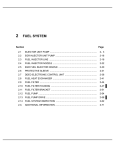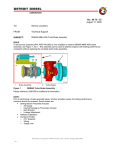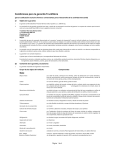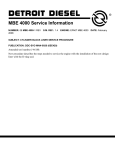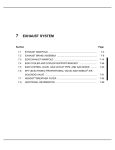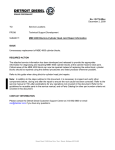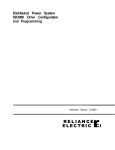Download Detroit Diesel EPA04 MBE 900 Specifications
Transcript
MBE 900 / 4000 Eparts Catalog Quick Reference Guide (ALL) MBE 900 / 4000 Serial Number Break Information Footnotes under certain parts contain important usage and serial number break information. Certain footnotes in eParts contain German terminology. For BIS MOTOR 833529, use Part number TO engine serial number break. For AB MOTOR 833530, use Part number FROM engine serial number break. NOTE: BIS/AB denotes the last six (6) digits of the serial number break. (ALL) MBE 900 / 4000 Kit Information NEW: eParts can denote kits with a prefix before the part description 1. “RS” stands for Repair Kit (Common for overhaul kits.) 2. “TS” stands for Service Kit 3. “DS” stand for Gasket Kit (ALL) MBE 900 / MBE 4000 Fuel Injectors MBE Fuel Injectors are located in the CYLINDER HEAD section. 1. Obtain and verify Engine Serial Number (ESN) 2. If not using ESN, select appropriate model. If using ESN, proceed to step 3. 3. Go to Engine Housing 4. Go Cylinder Head, Valves, Gasket Kit NOTE: Multiple images are shown in the Cylinder Head, Valves, and Gasket Kit section. Navigate through the image “Figures” to locate the correct part. (ALL) MBE 900 Air Compressors DO NOT use eParts Catalog. Use the following steps to order Air Compressor 1. Obtain and verify Engine Serial Number (ESN) 2. Order part number RA9061301415 TO ESN 455948. 3. Order part number RA9061304315 FROM ESN 455949. NOTE: On occasion, applications are equipped with a unique air compressor. Confirm against current air compressor before beginning the repair procedure. (ALL) MBE 900 Flywheels DO NOT use eParts Catalog. Use the following steps to order Flywheel. 1. For vehicles equipped with manual transmission, order part number A9060305905 2. For vehicles equipped with automatic transmission, order part number A9060300859 3. For vehicles equipped with a Euro specifications SACHS clutch, order part number A9060303405 Specifications are subject to change without notice. Detroit Diesel and the Spinning Arrows design are registered trademarks of the Detroit Diesel Corporation. Copyright © 2009, Detroit Diesel Corporation. All rights reserved. Detroit Diesel Corporation is a Daimler company. MBE 900 / 4000 Eparts Catalog Quick Reference Guide (ALL) MBE 4000 Front Sump Oil Pans Serial number break at 460933U0833530. Oil pan capacity changed from 40L to 36L. Reference 06 TS–03Rev (January 30th, 2006) before ordering parts in eParts Catalog. (EPA 04, 07) MBE 4000 Front Sump Die Casting Oil Pan Part A4600100913 shown as an option in eParts is not serviceable. Do not order. Reference 06 TS–03Rev (January 30th, 2006) before ordering parts in eParts Catalog. (EPA 04, 07) MBE 4000 Rear Sump Oil Pans Serial number break at 460933U0833530. Oil pan capacity changed from 40L to 36L. Order part number A4760101013 TO ESN 833529. Order part number A4600100813 FROM ESN 833530. NOTE: On occasion, applications are equipped with a unique oil pan. Confirm against current oil pan before beginning the repair procedure. (EPA 98, 04, 07) MBE 4000 Cylinder Head and Gaskets DO NOT use eParts Catalog. Reference Technical Service Letter 09 TS-11 (April 21, 2009) to order cylinder head and gaskets. (EPA 98, 04, 07) MBE 4000 Cylinder Liners and Pistons DO NOT use eParts Catalog. Reference Technical Service Letter 08 TS-8Rev (February 29, 2008) to order cylinder liners and pistons. (EPA 98, 04) MBE 4000 Turbobrake Assembly Turbocharger NOT serviceable for turbobrake assembly. Use the following steps in eParts Catalog to order the turbobrake assembly. 1. Go to MBE catalog or enter Engine Serial Number (ESN) 2. If not using ESN, select appropriate model. If using ESN, proceed to step 3. 3. Go to Fuel Filter and Turbocharger 4. Go to turbocharger 5. Select Call out “20” Turbobrake NOTE: Only engine brake is serviceable. Reference AP2006-036 (September 25, 2006) and 06 TS-22 (August 17, 2006) Looking for more? Check out the MBE / DD Platform Parts tutorial located on the eParts homepage. Specifications are subject to change without notice. Detroit Diesel and the Spinning Arrows design are registered trademarks of the Detroit Diesel Corporation. Copyright © 2009, Detroit Diesel Corporation. All rights reserved. Detroit Diesel Corporation is a Daimler company. No.: 09 TS-11 April 21, 2009 TO: Service Locations FROM: Technical Service SUBJECT: MBE 4000 Cylinder Head And Head Gasket Information NOTE: This document supersedes 07 TS-04Rev and AP2007-014. ISSUE A recessed grommet sealing area was machined around each coolant inlet and outlet port in the cylinder head to give a better mating surface for the thicker rubber seal in the head gasket. See Figure 1. The new cylinder head and gasket became effective with engine S/N: 0460866443 built on August 1, 2006. Current Cylinder Head With Recess Current Head Gasket With Raised Grommet Figure 1 – MBE 4000 Cylinder Head Recess and Head Gasket Grommet Detroit Diesel 13400 Outer Drive, West / Detroit, Michigan 48239-4001 09 TS-11 -2- 4/21/2009 Further improvements to the cylinder head is a change to a cast iron cup plug instead of a steel cup plug to prevent head cracking. See Figure 2. The new cylinder head became effective with engine S/N: 0460884866 built on April 25th, 2007. Former Steel Cup Plug Current Cast Iron Cup Plug Figure 2 – MBE 4000 Cylinder Head Cup Plug Another improvement to the head gasket includes the removal of the vent gap around the perimeter of the gasket. This will prevent water intrusion under the gasket which can cause rusting and pitting of the fire deck surfaces of the cylinder block and head, but ultimately does not affect the sealing surfaces. See Figure 3. The new cylinder head gasket became effective with engine S/N: 0460896913 built on September 3rd, 2007. Former Gasket With Open Vent Gap Current Gasket With Closed Vent Gap Figure 3 – MBE 4000 Cylinder Head Gasket Vent Gap REQUIRED ACTION Note these items when servicing the cylinder heads and gaskets. • Grommet style cylinder heads and gaskets MUST be used together on the same cylinder. Do NOT mix grommet and non-grommet style cylinder heads and gaskets on the same cylinder. • Grommet and non-grommet style cylinder heads and gaskets can be used in the same engine provided they are matched as noted above. Do NOT replace all six cylinder heads and gaskets simply to have all the same new parts on the engine. • Reference Technical Service letter 09 TS-9 for more information. 09 TS-11 -3- 4/21/2009 REQUIRED MATERIAL Table 1 provides a list of the current service part numbers. Stock of former part numbers CANNOT be returned and may be used until they are exhausted. Engine Type EPA04 after engine S/N: 0460866443 and all EPA07 Current Part Number Former Part Number(s) RA4600101720 R4600101120 A460016042027 RA4600102020 EPA04 prior to engine s/n 0460866443 A4570161220 A4600160420 R4600101120 RA4600101720 Description Cylinder Head with Valves Cylinder Head Gasket Cylinder Head with Valves A4600160520 A4570161120 A4570161220 A4600160420 Cylinder Head Gasket RA4570108620 4600100620 Cylinder Head with Valves All EPA98 A460016042027 A4570161120 A4570161220 A4600160420 Cylinder Head Gasket Current Part Comments Grommet style parts that must be used together. Non-grommet style parts that must be used together. NOTE: If you are reusing the former grommet style cylinder heads, use matching current grommet style head gasket P/N: A460016042027. Grommet style parts that must be used together. NOTE: If you are reusing the former non-grommet style cylinder head, use matching current non-grommet style head gasket P/N: A4600160520. Table 1 – MBE 4000 Cylinder Head and Gasket Part Numbers REPAIR PROCEDURE Refer to the EPA07 MBE4000 Service Manual (DDC-SVC-MAN-0026) and EPA04/98 MBE 4000 Service Manual (DDC-SVC-MAN-0023) for repair information. CONTACT INFORMATION Please contact the Detroit Diesel Customer Support Center at 313-592-5800 or email [email protected] if you have any questions. No.: 08 TS-8Rev February 29, 2008 TO: Service Locations FROM: Technical Support Development SUBJECT: MBE 4000 Coolant Leaks ISSUE MBE 4000 engines may exhibit a high mileage concern of coolant leakage around the cylinder liner. CAUSE The current stainless steel shim installed between the cylinder liner and cylinder block counterbore area cannot adequately seal out coolant in this area. The coolant acts as a lubricant, causing movement between the cylinder liner and cylinder block and subsequent wear in the counterbore area. Coolant will then leak past the counterbore area. See below for pictures showing the affected areas. Figure 1 – Leakage in the Counterbore Area Detroit Diesel 13400 Outer Drive, West / Detroit, Michigan 48239-4001 08 TS-8Rev Figure 2 – Leakage on the Shim Figure 3 – Leakage on the Liner Flange -2- 2/29/2008 08 TS-8Rev -3- 2/29/2008 REQUIRED ACTION To seal the counterbore area from coolant and prevent liner movement, Detroit Diesel has released a new cylinder liner design which uses an additional rubber D-ring just below the liner flange to seal against the coolant. See Figure 4. Figure 4 – New Design Cylinder Liner and D-ring Seal New cylinder block service procedures have been prepared to repair existing blocks. The procedure involves the following: • Cutting the failed cylinder block counterbores to leave a full contact area for the shim and liner flange. • Installation of a new design cylinder liner with an additional D-ring seal in all cylinder positions. REQUIRED MATERIAL Table 1 provides a list of the new service kit and individual part numbers. The liner kits contain the new liner, new 0.15 mm standard shim, new sealing D-ring, the two existing liner bottom o-rings, and the scraper ring (EPA04 only). The new 0.15 mm standard shim and sealing D-ring are also listed separately, as are thicker shims if the depth of the freshly cut counterbores require them to reach the correct cylinder liner protrusion specifications. Since the liners are being replaced, the piston rings must also be replaced, and the applicable ring kits are listed for your convenience. 08 TS-8Rev -4- A4600102050 A4600101950 Former Part Number A4600110610 A4600110210 A4609970045 NA A4600110159 A4570110259 A4600110359 A4600110459 NA, use former ⇒ NA, use former ⇒ NA, use former ⇒ A4570110459 A4570110559 A4600300424 A4600300324 A4600300124 New Part Number 2/29/2008 Description EPA04 and EPA07 EGR Cylinder Liner Kit EPA98 Non-EGR Cylinder Liner Kit Cylinder Liner D-Ring – Contained In New Liner Kits Cylinder Liner Shim (0.15 mm) – Contained In New Liner Kits Cylinder Liner Shim (0.3 mm) – As Needed Cylinder Liner Shim (0.5 mm) – As Needed EPA07 EGR Piston Ring Kit EPA04 EGR Piston Ring Kit EPA98 non-EGR Piston Ring Kit Table 1 – MBE 4000 Cylinder Block Counterbore Repair Parts REPAIR PROCEDURE • Reference SIB 08 MBE 4000-1Rev (EPA07) and SIB 08 MBE 4000-1Rev (EPA04) for information on cutting the cylinder block counterbores using the existing Kent-Moore PT-2250-B Porta-Tool. • Only the FAILED cylinders should have their counterbores cut. This decision is based on the condition of the cylinder block counterbore sealing area. See Figures 1-3 on pages 1 and 2 for examples of failed counterbores. • The machining of the counterbores MUST be done correctly to accept the cylinder liner shim and arrive at the correct liner protrusion specifications as listed in the EPA07 MBE 4000 Workshop Manual, DDC-SVC-MAN-0026 (6SE420) and MBE 4000 Workshop Manual, DDC-SVC-MAN-0023 (6SE412). • ALL liners must be replaced with the new version and D-ring, even if that particular cylinder is not having its counterbore cut. Installation of the new liner and D-ring seal should prevent future failures. • Ensure that the new liner diameter tolerance code corresponds to the one marked on the piston. The new liners should have a tolerance code B which requires a piston of either code BA or BC. Reference to sections 1.4.3 and 1.19.1.1 in the EPA07 MBE 4000 Workshop Manual, DDC-SVC-MAN-0026 (6SE420) and sections 1.3.2 and 1.18.1.1 in the MBE 4000 Workshop Manual, DDC-SVC-MAN-0023 (6SE412). • Start the repair by measuring the liner protrusion. Install the new liner with the new standard 0.15mm shim and measure the liner protrusion as noted by SIB 08 MBE 4000-1Rev (EPA07) and SIB 08 MBE 4000-1Rev (EPA04). Do NOT install the D-ring & O-ring at this point. Mark the liners for cylinder position. • If the liner protrusion values are not within specifications, then you will need to cut the counterbore. Reference section 1.4.1.3 in the EPA07 MBE 4000 Workshop Manual, DDC-SVC-MAN-0026 (6SE420) and section 1.3.1.2 in the MBE 4000 Workshop Manual, DDC-SVC-MAN-0023 (6SE412) for cylinder liner protrusion specifications. 08 TS-8Rev -5- 2/29/2008 • Install the new D-ring to the cylinder liner. Make sure the D-ring is installed dry with the flat surface against the vertical face of the liner. See Figure 4 above, and SIB 08 MBE 4000-1Rev (EPA07) and SIB 08 MBE 4000-1Rev (EPA04). Be careful not to over-stretch the D-ring when it is installed over the liner flange. • The shim MUST be installed into the cylinder block, not on the liner. • Before installing the cylinder liner with D-ring into the cylinder block, apply a light coating of clean engine oil to the D-ring. • Ensure the D-ring doesn’t roll or twist when installing the liner into the block. • Measure liner protrusion again. Follow the directions in 08 MBE 4000-1Rev (EPA07) and SIB 08 MBE 4000-1Rev (EPA04). The values should be the same as measured above. If not, remove the liner and check the installation. • If re-using the pistons, be sure to install new piston rings. • If installing new pistons, be sure to select the correct piston and piston cooling nozzle. Reference Technical Service letter 05 TS-55Rev2. Please note that the current piston kits (which contain the piston and liner) do NOT contain the new liner. Order only the individual piston and cooling nozzle. • Before installing the cylinder heads, ensure they are not worn or defective which may contribute to coolant leaks. For example, look for cracks around the cup plug on the rear face of the heads. CONTACT INFORMATION Please contact the Detroit Diesel Customer Support Center at 313-592-5800 or email [email protected] if you have any questions. No.: AP2006-036 September 25, 2006 TO: Service Locations FROM: Part Sales and Marketing SUBJECT : MBE 4000 Turbo Brake Assembly Service Parts PRODUCT GENERAL INFORMATION A new service assembly (P/N: R4571401206) is now available to install a REMAN MBE 4000 brake assembly, see Figure 1. This assembly can be used to address engines with braking performance issues without replacing the complete turbocharger assembly, see Figure 2. This new service assembly is compatible with 4601400171, 4601400271 and 4571400071—parts no longer serviced. Figure 1 Brake Assembly Figure 2 Turbo Brake Assembly=1-Brake Assembly and 2-Turbocharger PART NUMBER Non-serviced Part Numbers New Part Numbers N/A 4601400171 4601400271 4571400071 N/A E 4601400171 E 4601400271 E 4571400071 reliabilt® Part Numbers R 4571401206 R 4601400171 R 4601400271 R 4571400071 Description Brake assembly turbo brake assembly turbo brake assembly turbo brake assembly APPLICABLE ENGINE LINES All MBE 4000 engines equipped with the turbo brake assembly, EGR and Pre-EGR. ADDITIONAL INFORMATION Please see 18SP635 for installation instructions. CONTACT INFORMATION Please make sure all affected areas of your organization receive a copy of this letter. Contact your service location’s parts field sales representative for more information. Detroit Diesel Corporation 13400 Outer Drive, West / Detroit, Michigan 48239-4001 DA 1 No.: 06 TS - 22 August 17, 2006 TO: Service Locations FROM: Technical Support SUBJECT: REMAN MBE 4000 Turbo Brake Assembly ISSUE A new service assembly (P/N: R4571401206) is now available to install a REMAN MBE 4000 brake assembly, see Figure 1, No.1. This assembly can be used to address engines with braking performance complaints without replacing the complete turbo brake assembly. 1. Brake Assembly Figure 1 2. Turbocharger REMAN Turbo Brake Assembly Please reference 18SP635 for additional kit information. NOTE: Prior to performing a brake assembly repair, all other possible causes for braking performance concerns should be reviewed. Some causes are: • Sliding Sleeve Pneumatic Actuator o Air Supply o Internal Damage to Pneumatic Actuator o Bent Bracket o Linkage Adjustment • Software Calibration • Constant Throttle o CTV Solenoid o Wiring o Supply Line Detroit Diesel Corporation 13400 Outer Drive, West / Detroit, Michigan 48239-4001 DA 1 06 TS-22 -2- August 17, 2006 TURBO BRAKE ASSEMBLY REMOVAL PROCEDURE Remove the turbocharger from the engine as follows: PERSONAL INJURY To avoid injury before starting and running the engine, ensure the vehicle is parked on a level surface, parking brake is set, and the wheels are blocked. 1. Apply the parking brake, chock the wheels, and perform any other applicable safety steps. 2. Disconnect vehicle battery power. 3. Remove the exhaust pipe from the turbocharger. Refer to the applicable vehicle service manual. 4. Remove the turbocharger inlet air pipe. Refer to the applicable vehicle service manual. 5. Remove the oil feed and return pipes from the turbocharger. Refer to the MBE 4000 Service Manual (6SE412). 6. Disconnect the turbocharger speed sensor harness connector. Refer to the MBE 4000 Service Manual (6SE412). 7. Disconnect the turbocharger wastegate and sliding sleeve air lines. Refer to the applicable vehicle service manual. 8. Remove the turbocharger from the exhaust manifold and place the turbocharger on a bench. Refer to the MBE 4000 Service Manual (6SE412). Prior to disassembly of the turbo brake assembly, a routine inspection of the turbocharger should be completed. Areas of concern could include: • • • • Evidence of foreign objects entering and exiting the turbocharger Evidence of restricted air flow Evidence of lack of lubrication Evidence of turbine or compressor wheel damage TURBO BRAKE DISASSEMBLY PROCEDURE Disassemble the turbo brake as follows: 1. Remove the clevis pin from the ball socket on the sliding sleeve actuator and discard. 2. Using a large screw driver or pry bar, disconnect the sliding sleeve actuator ball socket from the sliding sleeve lever. 3. Inspect the sliding sleeve actuator for damage or binding and try to move the sliding sleeve lever. This is used as a general inspection and may pinpoint the area of concern. 4. Remove the two bolts (1) and v-band clamp (3) from the exhaust bypass pipe (2). Discard the two bolts (1), but save pipe and clamp for reinstallation. See Figure 2. 06 TS-22 -3- August 17, 2006 5. Remove the four (4) nuts holding the brake assembly to the housing and discard. See Figure 2. 1. 2. Bolt (2 qty.) Exhaust Bypass Pipe Figure 2 3. 4. V-Band Clamp Nut (4 qty.) Exhaust Bypass Pipe and Brake Assembly Nuts 6. Separate the assembly from the turbocharger housing. Set the turbocharger horizontally on a sturdy table. Protect the speed sensor and wiring from damage. a) Using a brass hammer, tap the turbocharger housing equally on two sides until a small gap is generated around the mating surface of the brake assembly and turbocharger housing. Do NOT hit the exhaust pipe connecting flange. See Figure 3. b) Once a gap is generated, use a large screwdriver or pry bar to apply even leverage 180° apart to separate the brake from the turbocharger housing. See bold arrows in Figure 3. Try to keep the brake assembly as straight as possible when removing. 1. Exhaust Pipe Connecting Flange Figure 3 Leverage Points NOTE: During most disassemblies the matrix usually stays in the turbocharger housing due to tight tolerance, and a slight build up of rust. See Figure 4. 06 TS-22 1. -4- August 17, 2006 Matrix Figure 4 Matrix Still Inside Housing 7. To remove the Matrix from the turbocharger housing do the following: a) Use an emery cloth to clean the edge of the turbocharger housing just above the Matrix lip. Do NOT use a die grinder or a powered sander. See Figure 5. 1. Housing Figure 5 2. Matrix Lip Matrix Lip and Housing b) Apply a small amount of penetrating oil just above the Matrix lip around the entire radius and allow it to set for a few minutes. The penetrating oil will seep down along the walls allowing the Matrix to be removed without damage. See Figure 6. 06 TS-22 Figure 6 -5- August 17, 2006 Applying Penetrating Oil to Matrix Lip NOTICE: If the Matrix will not turn by hand after penetrating oil has been applied, use a non marring strap wrench near the base to provide extra leverage. Do NOT hit the side of the Matrix. A rocking motion can cause damage to the Matrix or the turbine blades. See Figure 7. Figure 7 Broken Matrix (separated) c) Grab the Matrix with two hands and rotate it back and forth while pulling straight up. If the Matrix binds up, lightly tap the TOP with a rubber mallet to re-seat it in the bore. Re-inspect the housing bore for a lip and remove if necessary. Continue the process until the Matrix is removed. See Figure 8. 06 TS-22 -6- August 17, 2006 Figure 8 Matrix Removal 8. Do the following to inspect the turbine blades and housing for wear: a) Inspect the turbine blades for wear, cracks, chips, or evidence of foreign material entering the turbocharger. See Figure 9. Figure 9 Checking Turbine Blades for wear b) Inspect the inside of the housing for single or multiple cracks. The housing can ONLY be reused if the cracks do not intersect. See Figure 10. 1. Single Crack (No intersecting cracks – reuseable) Figure 10 2. Multiple Cracks (Intersecting cracks – non- reusable) Intersecting vs. Non-Intersecting Cracks 9. Use an emery cloth and clean all mating surfaces between the housing and the new brake assembly. 06 TS-22 -7- August 17, 2006 BRAKE ASSEMBLY PROCEDURE Assemble the brake as follows: 1. Place the brake assembly and turbocharger housing on their sides, see Figure 12. 2. Remove the tie wrap holding the Matrix together with the brake assembly. 3. Ensure the Matrix is seated over the guide baffle. See Figure 11. 1. 2. Non-seated Matrix Seated Matrix Figure 11 3. Guide Baffle Non-Seated and Seated Matrix 4. Ensure the brake assembly is parallel to the turbocharger housing and slide the two assemblies together until they are fully seated. See Figure 12. 1. Brake Assembly Figure 12 2. Turbocharger Turbo Brake Assembly NOTICE: Due to the tight tolerance of the Matrix to the housing, care must be taken not to damage either assembly. 5. Install and torque in a diagonal sequence the four turbo brake assembly nuts to 40 N·m (29 lb-ft). 06 TS-22 -8- August 17, 2006 6. Install the exhaust bypass tube flange to the brake assembly using two M8 X 16 bolts and torque to 30 N·m (22 lb-ft). 7. Install the opposite end of the exhaust bypass tube to the turbocharger housing and torque the v-band clamp bolt to 5-7 N·m (4-5 lb-ft). 8. Connect the turbocharger to the exhaust manifold. Refer to the MBE 4000 Service Manual (6SE412). 9. Connect the turbocharger wastegate and sliding sleeve air lines. Refer to the applicable vehicle service manual. 10. Connect the turbocharger speed sensor harness connector. 11. Connect the oil feed and return pipes to the turbocharger. Refer to the MBE 4000 Service Manual (6SE412). 12. Connect the turbocharger inlet air pipe. Refer to the MBE 4000 Service Manual (6SE412). 13. Connect the exhaust pipe to the turbocharger. Refer to the applicable vehicle service manual. 14. Connect vehicle battery power. PERSONAL INJURY Diesel engine exhaust and some of its constituents are known to the State of California to cause cancer, birth defects, and other reproductive harm. • Always start and operate an engine in a well ventilated area. • If operating an engine in an enclosed area, vent the exhaust to the outside. • Do not modify or tamper with the exhaust system or emission control system. 15. Start engine and check for air or oil leaks. CONTACT INFORMATION Please contact the DDC Customer Support Center at 313-592-5800 if you have any questions. No.: 06 TS – 03Rev January 30, 2006 TO: DDC Distributors, FLLC Dealers FROM: Technical Service SUBJECT: New Oil Pan For MBE4000 Engines ISSUE New 36L capacity front sump oil pan for certain MBE4000 engines. ADDITIONAL INFORMATION MBE has installed a new front sump oil pan (P/N: 4600100713) that contains 36L (38 qt.) of oil instead of the former 40L (42.3 qt.) oil pan (P/N: 4760100913) effective with engine serial number 0460833530. • Do not overfill the crankcase when filling the engine with oil. Refer to the MBE4000 Operators Guide (6SE411) for information on correctly filling the engine with oil and checking the level on the dipstick. • The new oil pan is used on the following engines: o All EGR engines with front sump o Non-EGR engines with front sump for Right Hand Drive export applications (Australia, New Zealand, etc.) • The new oil pan is NOT used on the following engines: o Non-EGR engines with front sump for Left Hand Drive applications (Mexico, etc.) o Any rear sump application o These engines will convert to the new 36L pan in late 2006 • Other new parts associated with this change are: o Oil pickup tube o Dipstick and dipstick tube o Oil fill tube o Bracket for dipstick tube and oil fill tube o Oil centrifuge cover • Do NOT install the new 36L oil pan on an engine that was built with a 40L oil pan without fully investigating all of the changes between the two particular engines • Engines with the new oil pan are identified with a “36L” sticker on the engine oil fill cap (See Figure 1 below) Detroit Diesel Corporation 13400 Outer Drive, West / Detroit, Michigan 48239-4001 DA 1 06 TS-03Rev -2- January 30, 2006 Figure 1 – Identifying Label on Engine Oil Fill Cap CONTACT INFORMATION Please contact the DDC Customer Support Center at 313-592-5800 if you have any questions.





















